Causes of failure of the generator diode bridge. How to check if the generator is working in a car? Basic generator malfunctions and ways to eliminate them
Since a car generator is an electromechanical device, its main faults are divided into two categories - electrical and mechanical. Electrical faults are breakdowns diode bridge, interturn short circuits, winding damage, relay-regulator breakdowns, brush burnout and wear, as well as breakdowns. But mechanical failures include damage to fasteners, problems with bearings, destruction of the generator housing, violation proper operation belt drive and other malfunctions that have no connection with the electrical “stuffing” of the generator. Very often, signs indicating a generator breakdown are caused by completely different problems that appeared earlier. For example, a generator malfunction may be the result of burnt contacts located in the ignition switch housing. Sometimes the light indicating that the generator is not working is lit due to a broken relay.
Typical signs of a faulty generator in a car:
1: The battery is being overcharged or discharged.
2: When the engine is running, the battery discharge light is on or flashing.
3: Significant increase in headlight brightness with increasing speed. This can happen during revving after idling, but the brightness of the headlights cannot increase constantly.
4: The sound signal is too weak, the headlights are not bright enough when the engine is running.
5: The presence of specific sounds that the generator makes.
Methods for diagnosing faults:
Many car enthusiasts are accustomed to checking the generator using old methods, which are prohibited from being used on modern cars. For example, some garage technicians advise removing the terminal from the battery. Such a decision can cause failure of various vehicle electronics, so it’s not worth the risk. Generator diagnostics today are carried out by determining the voltage in the electrical network or checking the device using special equipment. At the first stage, the specialist determines the voltage at the battery terminals. Then he starts the engine and takes measurements with the engine running. When the engine is turned off, the voltage should be approximately 12 Volts, but after starting the unit, the indicator should reach 13.8-14.7 Volts. If the voltage is higher, this is a sign of “overcharging”, which is caused by a breakdown of the relay regulator. If there is a deviation to the smaller side, no current is supplied. The reason may be a circuit failure or a generator malfunction.
Causes of malfunctions As a rule, the main causes of generator malfunctions are the occurrence of corrosion processes and normal operational wear. Almost all mechanical failures are the result of prolonged use of the unit. In new cars, generators are equipped with bearings closed type which periodically need to be replaced. The same applies to the electrical component of the device - often they simply have to be replaced as an assembly. Additional factors that cause breakdowns: poor quality of parts; abnormal operating conditions; exposure to elevated temperatures, salt, dirt, liquids and road chemicals. Checking the generator yourself The simplest option for those who do not know how to check the generator, it is to inspect the fuse. If the element works, we move on to the generator itself. It is necessary to make sure that the belt is not torn, the rotor rotates freely, and the housing is not damaged. Next, the slip rings and brushes are diagnosed. Brushes need to be changed periodically. If you notice excessive sparking, this indicates the need to purchase new generator brushes. Sometimes autogenerator malfunctions are caused by stator failure. Experts note that the most common mechanical components of a generator that fail are bearings. Their wear can be determined by the characteristic whistling sound during generator operation. Worn bearings must be replaced without fail. Sometimes the generator does not work efficiently because the drive belt tension is too weak. Very often such a whistle appears during acceleration of a car. Diagnostics of the rotor field winding is performed using a multimeter. On the device, select the resistance determination mode and connect it to the slip rings of the unit. The resistance should be between 1.8-5 Ohms. If you see lower readings, there is a short circuit in the turns. If the indicators are higher than the mentioned values, a winding break has occurred.
To check the generator stator windings for ground fault, disconnect them from the rectifier unit. If the multimeter displays resistance readings with infinitely large parameters, there is no normal contact of the windings with the body (i.e., “ground”). The diodes in the rectifier block are also tested using a multimeter (we first disconnect them from the stator windings). Select the “diode test” operating mode. The red probe should be connected to the “+” or “-” of the rectifier, but the black probe (negative) is connected to the phase output. Then the probes should be swapped. If, when performing this procedure, the instrument readings differ significantly from the previous ones, the diode is working normally. If there are no differences, the diode has failed. The malfunction of the diode bridge of the generator is also confirmed by oxidation of the contacts as a result of overheating of the radiator.
GENERATOR REPAIR AND TROUBLESHOOTING:
Breakdowns mechanical type They are “treated” by simply replacing inoperative components with new or working ones. On old generators, slip rings are often ground. Alternator drive belts should be replaced if they are broken, overstretched, or have visible defects. It is recommended to replace rotors and stators whose windings are damaged, since almost no one does rewinding anymore.
A car's generator is a very significant element of its design, which, together with the car's battery, provides many important components vehicle the necessary electricity. Thus, thanks to the energy received from the generator, the ignition system, lighting devices and various electronic devices operate, which include modern car enough. Of course, even the slightest malfunction of the generator will affect the operating efficiency of any electrical appliances on the machine, right down to complete blocking their activities.
Therefore, it is advisable for a car owner to have at least general idea about the main causes of generator malfunctions, their characteristic features, diagnostic and elimination methods.
1. What is a generator?
A car generator is a device responsible for converting mechanical energy received from the engine into its electrical version.
 In modern vehicles, the generator is used to power the ignition system, on-board computer, various automotive lighting equipment, diagnostic systems and other electrical consumers. In addition, it is he who provides the battery charge. IN modern world Such devices are subject to a number of requirements, among which reliability comes first. This is not surprising, because the generator is designed to maintain uninterrupted operation most of the components of the car (the standard power of a modern passenger car unit is about 1 kW).
In modern vehicles, the generator is used to power the ignition system, on-board computer, various automotive lighting equipment, diagnostic systems and other electrical consumers. In addition, it is he who provides the battery charge. IN modern world Such devices are subject to a number of requirements, among which reliability comes first. This is not surprising, because the generator is designed to maintain uninterrupted operation most of the components of the car (the standard power of a modern passenger car unit is about 1 kW).
The first generator “saw” the world in 1832, and its “parents” were the Parisian technical scientists - the Pixie brothers. Of course, at that time such a design was far from perfect, and it was difficult to use. To operate such a machine, people were forced to rotate a heavy permanent magnet, which created an alternating electric current on two wire coils fixed near its poles. This generator had a device for leveling the current, and to increase the power of electrical machines, scientists of those times began to increase the number of magnets and coils.
Thus, one of the “new generation” machines was the generator Emil Stehrer, designed in 1843. It was equipped with three strong moving magnets and six coils that rotated around a vertical axis.
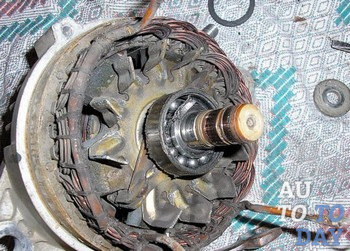 The first stage of the creation and subsequent development of electromagnetic generators (covering the period up to 1851) was marked by the fact that in order to obtain magnetic field Permanent magnets were used, and in the second stage (from 1851 to 1867) they were replaced by electromagnets, which contributed to an increase in the power of the generator itself. The power for the electromagnet winding came from a small autonomous current generator with permanent magnets.
The first stage of the creation and subsequent development of electromagnetic generators (covering the period up to 1851) was marked by the fact that in order to obtain magnetic field Permanent magnets were used, and in the second stage (from 1851 to 1867) they were replaced by electromagnets, which contributed to an increase in the power of the generator itself. The power for the electromagnet winding came from a small autonomous current generator with permanent magnets.
The first cars were equipped with DC collector generators, and the collector unit itself required regular monitoring and maintenance, seriously limiting the load current. With the advent of strong diode rectifiers (first of the selenium type, and later of the silicon type), it became possible to use synchronous generators in vehicles alternating current, which had much more advantageous characteristics: they were approximately three times lighter and much more reliable with the same power ratings and a more stable output current.
Nowadays, synchronous three-phase alternating current electric generators are installed on cars, and a three-phase device created according to the Larionov scheme acts as a rectifier.
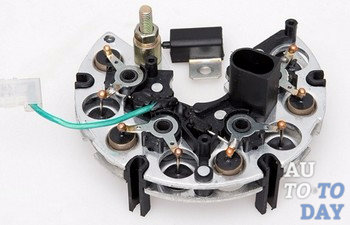 Such generators have sufficient strength, a long working life, a relatively small weight and the same dimensions, and have a low noise level and radio interference. However, the main requirement for this mechanism there is a sufficient level of power and constant current supply.
Such generators have sufficient strength, a long working life, a relatively small weight and the same dimensions, and have a low noise level and radio interference. However, the main requirement for this mechanism there is a sufficient level of power and constant current supply.
The generator power must be sufficient to simultaneously supply power to operating electrical consumers and charge the battery. Moreover, even if all regular consumers are used at low engine speeds, the battery should not be significantly discharged. Also, the generator is required to maintain the voltage of the on-board network not only within predetermined limits, but also over the entire range of electrical loads.
2. What are the generator malfunctions and how can they be eliminated?
Faults in the electrical equipment of a car occupy one of the leading positions in the list of the most frequent breakdowns. Conventionally, they are divided into two groups: the first is malfunctions of current sources (battery or generator), and the second is malfunctions of its consumers (optics, ignition, on-board computer, etc.). A malfunction in the operation of at least one of the electrical current sources causes a general malfunction of the vehicle and exposes it to operation in abnormal modes, and in some cases leads to immobilization of the vehicle.
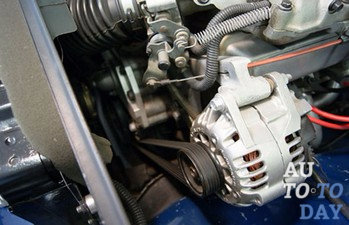 Considering the fact that a generator is not only electrical, but also mechanical device, it would be quite logical to divide it all possible problems into two categories - mechanical and electrical. The first option includes destruction of the housing, fasteners, malfunction of bearings, belt drive, pressure springs and other malfunctions that are in no way related to the electrical part.
Considering the fact that a generator is not only electrical, but also mechanical device, it would be quite logical to divide it all possible problems into two categories - mechanical and electrical. The first option includes destruction of the housing, fasteners, malfunction of bearings, belt drive, pressure springs and other malfunctions that are in no way related to the electrical part.
The second group, that is, electrical problems, includes winding breakage, diode bridge failure, interturn short circuits, rotor runout, brush wear/burnout, breakdowns, relay-regulator malfunctions and all kinds of short circuits.
True, quite often the symptoms indicating typical generator malfunctions turn out to be the result of completely different reasons. For example, poor contact in the field winding fuse socket does indicate a malfunction of the generator, but the same opinion may also arise due to burnt contacts located in the ignition switch housing. Likewise, a constant glow of the indicator lamp, signaling a generator malfunction, may be a consequence of a relay failure.
The main symptoms of a malfunction car generator There is:
1) Continuous lighting (or flickering) of the battery discharge indicator lamp when the engine is running;
2) Completely discharged or overcharged battery;
3) Dim glow of car headlights or a barely audible sound signal when the engine is running;
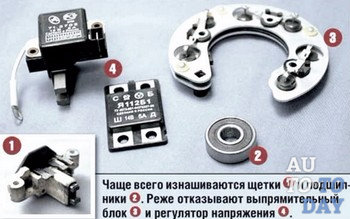 4)
A significant change in the brightness of the lights with an increase in the number of revolutions. This option is considered acceptable when there is an increase in speed (over-throttle) from idle mode, however, after the headlights come on brightly, it should no longer increase, remaining at the same level;
4)
A significant change in the brightness of the lights with an increase in the number of revolutions. This option is considered acceptable when there is an increase in speed (over-throttle) from idle mode, however, after the headlights come on brightly, it should no longer increase, remaining at the same level;
5) Extraneous sounds (squeaking or howling) that come from the generator.
Now we will look at the most common generator malfunctions and how to fix the problem. So, if the drive belt is slipping, then you will need to tighten it better, after first making sure that the bearings are functioning properly.
If the brushes are stuck, you should clean them of dirt, check the brush holder and the force of the brush springs. If necessary, replace faulty elements. The problem of burning slip rings is solved by cleaning them and, if necessary, grooving them.
If the rotor touches the stator poles, then you need to check the bearings and their seating locations, and in case of severe wear, the damaged parts should be replaced. Problems in the operation of the voltage regulator and a break in the circuit are solved by replacing the specified regulator and eliminating the break.
If the generator sends charging current, but does not provide sufficient charge to the battery, then the reason must be sought in:
1) Poor contact between the generator ground and the voltage regulator ground (you should check the integrity of the wires and the reliability of the contact itself);
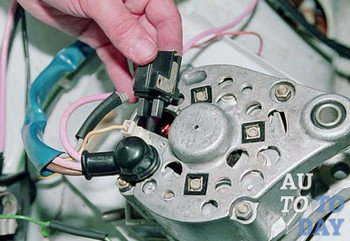 2)
Triggering of the voltage regulator protective relay, which is based on a short to ground in the generator excitation circuit (find the location of the short circuit and repair the fault);
2)
Triggering of the voltage regulator protective relay, which is based on a short to ground in the generator excitation circuit (find the location of the short circuit and repair the fault);
3) Worn or stuck brushes (the problem can be solved by replacing them or cleaning them from dirt);
4) Oiling and other contamination of slip rings (wipe the parts with a cloth soaked in gasoline);
5) Malfunction of the voltage regulator. If this is indeed the reason, then most likely you will have to change the device;
6) Also, the cause of this phenomenon may be a turn short circuit, an open circuit of one of the phases of the stator winding, or a breakdown of the diodes of the rectifier unit. In this case, you should disassemble the device, check the condition of the stator winding for breaks or short circuits and, if necessary, replace the faulty part.
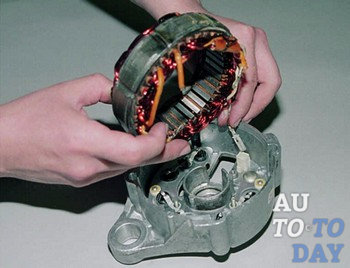 Poor alternator belt tension or worn and damaged bearings can be corrected by appropriate adjustment and replacement. When loosening the generator pulley nut, tighten the nut and wear seat bearing indicates the need for a new part.
Poor alternator belt tension or worn and damaged bearings can be corrected by appropriate adjustment and replacement. When loosening the generator pulley nut, tighten the nut and wear seat bearing indicates the need for a new part.
If you heard that the generator began to “howl” (an interturn short circuit occurred), then in this case only a new stator can solve the problem. Separately, it should be noted the need for regular monitoring of tension and general condition drive belt, so that in case of the slightest cracks and delaminations, the damaged part can be replaced in time.
3. Self-diagnosis, or how to figure out generator problems
Determining a malfunction on your own can be very difficult, especially if special equipment is required to diagnose it, as, for example, in the case of interturn winding short circuits. Quite often, problems in the performance of the generator appear due to the short circuit of the windings to the “housing”. In this case, its presence will help determine An ohmmeter is a device designed to measure resistance. Using this tool, you can also diagnose the diode bridge and connecting wires for their integrity or determine the presence of contact of the brush holders.
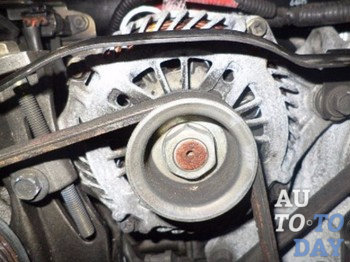 In most cases, possible generator malfunctions can be detected using the battery charge monitoring indicator: if the indicator lamp does not light up when you turn on the ignition, the reasons for this may be:
In most cases, possible generator malfunctions can be detected using the battery charge monitoring indicator: if the indicator lamp does not light up when you turn on the ignition, the reasons for this may be:
- battery malfunction;
Malfunction of the control light itself;
Lack of contact or damage to the integrity of the wires in the indicator circuit;
Worn generator brushes or poor contact on the brush assembly;
Problems with the voltage regulator.
In cases where the indicator lamp is constantly lit, regardless of the operating mode power unit, then the following problems may be present in the operation of the generator:
- breakdown of diodes;
Worn or weakened drive belt;
Open circuit or short circuit in the stator winding;
Fault or failure in the voltage regulator settings.
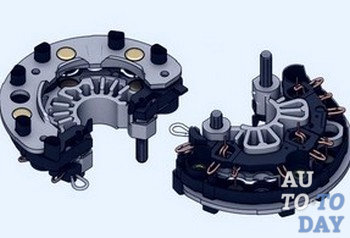 Evidence of the normal operation of a car generator is a stable voltage at the output (that is, at the terminals of the device), corresponding to 13.8 - 15.5 Volts. If the voltage threshold is too high, this can cause damage to the electrical elements of the automotive circuit, as well as affect the destruction of the battery. The cause of this phenomenon is often a faulty voltage regulator or inaccurate adjustment of the specified device.
Evidence of the normal operation of a car generator is a stable voltage at the output (that is, at the terminals of the device), corresponding to 13.8 - 15.5 Volts. If the voltage threshold is too high, this can cause damage to the electrical elements of the automotive circuit, as well as affect the destruction of the battery. The cause of this phenomenon is often a faulty voltage regulator or inaccurate adjustment of the specified device.
In addition, too high an output voltage is often the result of a breakdown of the diode bridge, poor contact at the generator body terminal, or evidence of interturn short circuits on the rotor winding.
True, in some cases, the culprit for increased voltage in the on-board network is the battery when a short circuit occurs in any of its sections. Therefore, when trying to determine the causes of a generator malfunction, you should not forget about this point.
At home the most in a simple way Diagnosis of the generator device includes checking the fuse. If everything is fine with it, then you can move on to inspecting the unit itself and its location. First of all, the free rotation of the rotor, the integrity of the belt and other components (wiring, housing, etc.) are checked.
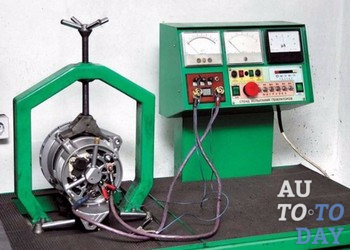 If nothing is found that could cause suspicion, then check the brushes and slip rings. As a rule, during long-term use the brushes wear out and can become warped or jammed. Slip ring grooves often become clogged with graphite dust, requiring immediate cleaning (excessive sparking will be a sign of this problem).
If nothing is found that could cause suspicion, then check the brushes and slip rings. As a rule, during long-term use the brushes wear out and can become warped or jammed. Slip ring grooves often become clogged with graphite dust, requiring immediate cleaning (excessive sparking will be a sign of this problem).
Pay attention to the bearings and stator, because there are often cases of serious wear of these parts.
To check the rotor field winding for short circuits or breaks, you can use a multimeter switched to ohmmeter mode (to measure resistance). It is connected to the slip rings of the generator. The permissible resistance, which is considered to be the norm, should be in the range from 1.8 to 5 Ohms. Values below this figure will indicate the presence of a short circuit, and if the values are above it, then the problem is a direct break in the winding.
The stator winding is checked for ground fault by first disconnecting it from the rectifier unit. If the multimeter gives a very high resistance reading, there is no doubt that there is no contact between the stator windings and the housing, that is, “ground”.
The diodes located in the rectifier block can also be checked using a multimeter, having first been completely disconnected from the stator winding. Select the appropriate mode on the device (“diode test”) and connect the positive probe to the plus or minus of the rectifier, and the negative probe to the phase terminal. After performing this action, the probes must be swapped. If the second multimeter readings are very different from the previous ones, this means that everything is in order with the diode; if they are not different at all, the part is faulty. Most a clear sign the rapid “death” of the generator diode bridge is oxidation of the contacts, which is caused by overheating of the radiator.
Subscribe to our feeds at
The task of a car generator is to generate electricity, which is used to power the car's systems. If the generator fails, its functions are automatically transferred to the battery. However, such a transition is not a normal solution, since even a fully charged battery will not last long. You can reach the garage or the nearest service station if the distance to them is several tens of kilometers. But you won’t be able to drive for a long time on one battery. It will just gradually discharge.
Main signs of generator malfunction
If your car exhibits some of the following symptoms, then with a high probability they indicate a malfunction of the generator and, therefore, it is worth diagnosing it in order to timely identify the main breakdowns and defects of the car generator.
- If the battery discharges too quickly, this indicates a faulty generator;
- If the battery warning lamp lights up or flashes while the engine is running;
- If the headlights noticeably dim or become weaker, this is also one of the signals that there is a malfunction in the generator;
- When the engine is running, noises, tapping, and squeaking noises are heard.
Basic generator malfunctions
Is it possible to check on your own how serious the problem is? Perhaps it can be fixed on the spot? In some cases this is actually possible to do.
Self-diagnosis of generator faults - reminder
A reminder for checking breakdowns with your own hands. Some malfunctions indicating certain breakdowns or wear of generator parts:
First you need to check the generator fuse.
Next, the free rotation of the rotor is checked. To check the rotor field winding for short-circuited turns or breaks, you need to connect a multimeter, switched to resistance measurement mode, to both contact rings of the generator. Normal resistance is from 1.8 to 5 ohms. The readings below indicate the presence of a short circuit in the turns; above – direct winding break.
Belt integrity and tension. Loose alternator drive belt tension may cause poor operation. One of the signs of such a malfunction may be a high-pitched whistle from under the hood when the car accelerates or accelerates.
Checking the wires. Inspect wires for oxidation, insulation damage, or burnout.
Checking the generator housing. Visual inspection for cracks, damage, etc.
The brushes and slip rings of the generator are checked. The brushes wear out during operation, they can simply jam or warp, and the grooves of the slip rings become clogged with graphite dust. This is evidenced by excessive sparking.
Bearings. A sign of this malfunction is a howling or whistling sound during operation. In this case, the bearings should be replaced immediately.
Stator failure. To check the stator winding, it should be disconnected from the rectifier unit. Resistance reading on a multimeter having "infinite" great importance indicate the absence of contact of the stator windings with the housing (“ground”).
Checking diodes. To check the diodes in the rectifier block, use a multimeter (after completely disconnecting from the stator windings). First, for example, the positive probe is connected to the “+” or “–” of the rectifier, and the negative probe to the phase terminal. Next, the probes are swapped. If the values of the multimeter readings differ greatly, then this is evidence that the diode is working; if they do not differ, then it is faulty. Or if the contacts are oxidized due to overheating of the radiator, then this is direct evidence that the diode bridge of the generator will soon “break”.
First you need to make sure that the generator is not working. To do this, measure the voltage at the battery terminals with a tester with the engine off. Remember the readings. Then start the engine, let it run for a couple of minutes at medium speed with a load, for example, with the headlights on, and then take the measurements again. If the voltage increases slightly or remains the same, then the generator is working properly. Typically the voltage is around 14V.
Another method for checking the generator. With the engine running, disconnect the positive cable from the battery. If the engine continues to run, power is supplied from the generator. If the engine stalls, then the generator is faulty.
We list the main ways to determine a generator malfunction:
- Check the condition of the alternator belt. If it is broken, the problem is solved by replacing it. Oddly enough, this is the easiest way to restore the functionality of the generator. Of course, if you have a spare belt. The belt may be intact but loose. In this state, it does not ensure full operation of the generator. Press it with your finger to check. If the belt bends by 1-1.5 cm, then its tension is considered normal.
- Check the vehicle's power supply voltage. It is enough to measure it with a tester in the cigarette lighter. It should not be more than 14.5 V. If the voltage value is higher, then a malfunction of the relay regulator should be suspected. This relay is responsible for maintaining DC voltage at any engine speed. If it fails, there is a risk of damage to electrical equipment from the resulting increased voltage, as well as overcharging the battery and causing it to boil.
If the voltage drops below 13 V, then one of the reasons may be a failure of the diode bridge. The rectifier bridge can be checked using a voltmeter tester. With the engine running, connect one probe of the tester in AC mode to connector “B+” or connector “30”, and the other probe to ground. The voltage should not exceed 0.5 V. If the value is greater, then the bridge is faulty.
Very often, problems with the generator arise when the brushes located in the brush holder become jammed. Failure is also often caused by dirt accumulated on the slip rings or oxidation of these rings. Disassembling and cleaning the generator helps to cope with this defect. The position and condition of the brushes are determined visually. If they protrude from the brush holder very slightly, less than 5 mm, then the brush holder with brushes must be replaced.
To check the rotor and stator windings, it is necessary to disassemble the generator. The tester probes are applied to the slip rings. If the resistance of the windings is about 5-10 Ohms, then the windings are working properly. If somewhere the circuit has infinite resistance, then this indicates its break. The resistance between each slip ring and the generator housing is also measured. If there is a short circuit, the tester will show it. Before checking, you need to remove the rectifier bridge.
If your generator fails, don't panic. This refusal is unpleasant, but not critical. If you approach the problem competently, then in most cases you will be able to complete the trip safely.
October 19th, 2016  Admin
Admin
Among vehicle breakdowns, the most common failure is the failure of electrical equipment. All electrical equipment can be divided into current sources, current consumers and auxiliary devices. Current consumers include optics, ignition, climatic equipment, anti-lock wheel systems, security systems, lighting devices and other equipment. All these systems will not operate without failures without well-functioning power supplies.
A three-phase alternating current synchronous generator is used as a power source in passenger cars, driven by the main engine. Its power is 700-1,000 W. The automotive industry has switched to installing cars alternating current generators (previously they installed direct current generators) when powerful diode rectifiers appeared. This made it possible to reduce the weight of the unit by three times. Some consumer systems (car radio, anti-theft system, brake lights, lighting and others) must work even when the engine is turned off. Their continuous work provides a car battery. It is charged from a running generator and smoothes out voltage drops when connecting energy-intensive consumers.
It is impossible to understand generator malfunctions without knowing what it consists of and how it works.
Car generator - design and principle of operation
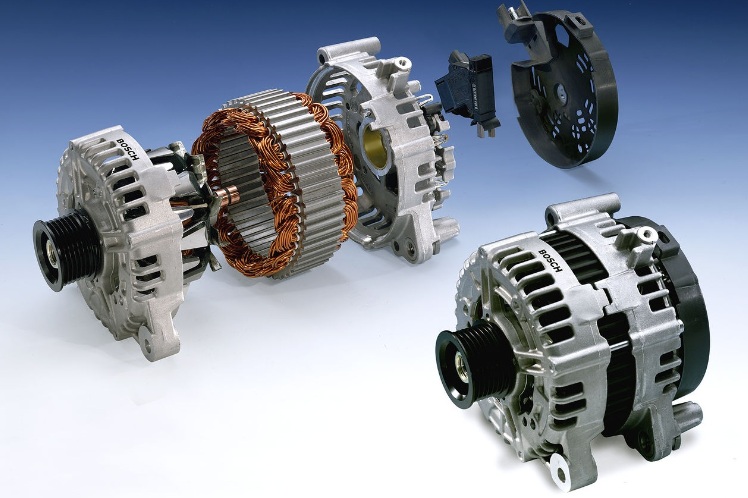
Into the body modern generators Built-in three-phase diode rectifier and voltage regulator. Below we will look at how a car generator works.
Pulley transmits rotation using a belt drive from the engine output shaft to the rotor.
Rotor- this is the generator shaft to which rotation from the engine is transmitted. Two beak-shaped steel bushings are mounted on it, between which there is an excitation winding. The output contacts of the excitation winding are connected to slip rings.
Stator is a package of steel sheets assembled in the form of a pipe. The stator slots contain a three-phase winding. It produces power.
Rectifier block (diode bridge) consists of two heat sinks (positive and negative), each of which is connected to three powerful diodes. The unit serves to convert the alternating current of the generator into direct current, or rather into pulsating current with a high frequency, required by voltage consumers.

Diode module protective cover
Voltage regulator- a device that maintains a certain voltage change interval, safe and sufficient for the operation of car current consumers, when the speed of rotation of the motor shaft, and therefore the rotor, changes in the electrical load, and the temperature of the environment.
Brush unit– a design that ensures contact of spring-loaded brushes with the rotor rings. The design is made of plastic, removable.
Generator housing combines all its components, has output contacts for connection to the electrical equipment system, is mounted on the car engine, and consists of two covers.
We have disassembled the structure of a car alternator, now we need to figure out how it works.
When the ignition is turned on, the generator rotor is driven by the engine. The field winding creates an electromagnetic field that induces electricity in the stator windings. Then the voltage regulator corrects the surges to 13.8 ÷14.2 V. The adjusted voltage is supplied to the battery.
The most common generator malfunctions:
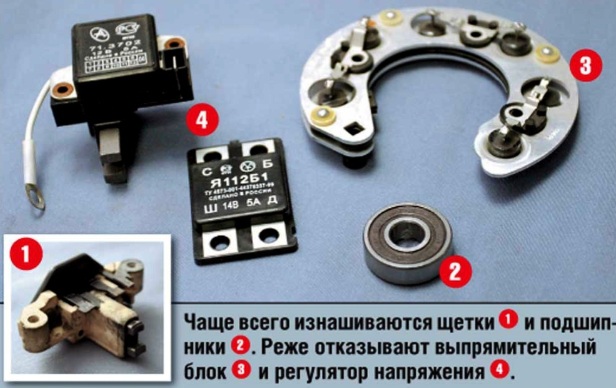
- damage or wear to the pulley on the crankshaft, which transmits rotation from the engine to the rotor;
- problems with the brush assembly or wear of the current-collecting brushes;
- malfunction of the voltage regulator;
- breakdown of the diode bridge;
- destruction of the rotor shaft bearing;
- violation of the integrity of the charging circuit wires or output terminals.
- break or short circuit of windings;
- contamination of slip rings, including due to burning;
The most common battery failures:
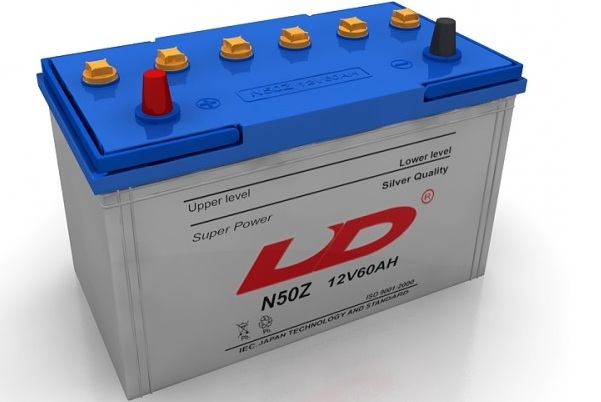
Automotive accumulator battery used in a car as an additional power source when the engine is not running and to start the engine. Passenger cars are equipped with batteries with a voltage of 12 V. The type of batteries is lead-acid.
- damage to the electrodes (mechanical or chemical);
- short circuit of the battery plates;
- violation of the integrity of the battery case, depressurization of cans;
- oxidation of battery terminals.
Types of generator faults
Mechanical faults include malfunction of bearings, mechanical damage to the housing, fasteners, springs, belt drive, pulleys, etc.

Electrical - these are brush burnout, rotor runout, interturn short circuits, diode bridge breakdowns, breakdowns, winding breaks, relay malfunctions, etc.
Signs of a faulty generator:
ABOUT possible malfunctions generator should be considered if
- the battery discharge indicator lights up or flashes while the engine is running;
- the battery has been discharged or boiled out (overcharging);
- the brightness of the headlights has decreased;
- Squeaking, howling, and other extraneous sounds come from the generator.
Generator fault diagnosis
Unstable operation of the generator does not recharge the battery. The moment the battery is completely discharged, the engine will stall and the car will stop in the most inappropriate place. To avoid this situation, you should periodically check the serviceability of this unit and the battery.
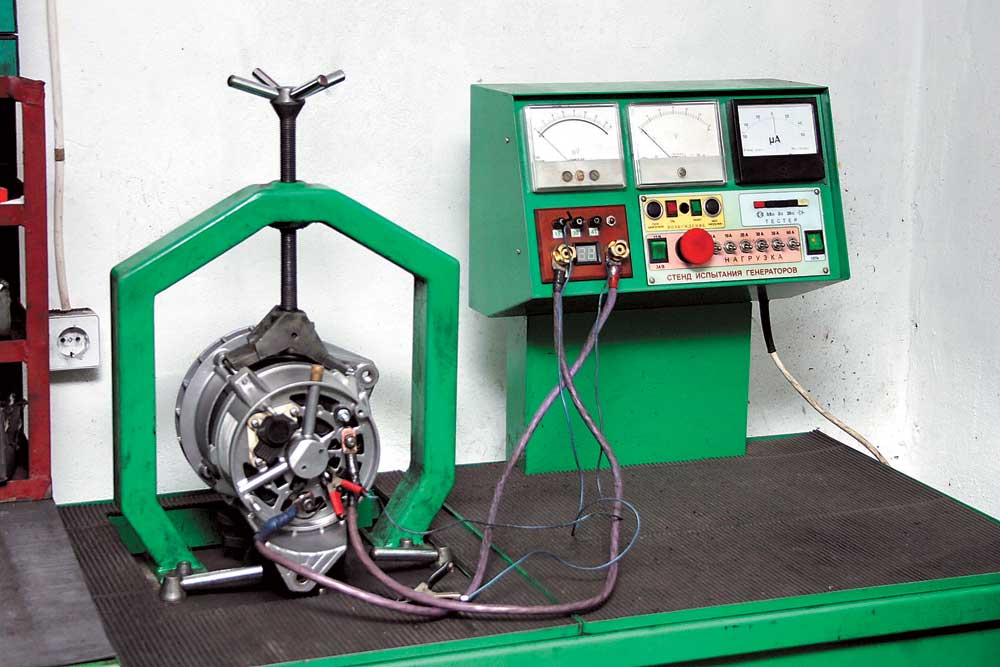
Generator diagnostics should only be done using a voltmeter or ammeter.
When diagnosing or repairing a generator, safety regulations must be strictly followed. In order not to destroy the generator during testing, under no circumstances should you:
- Check by short circuit, “for spark”. Significant changes voltage will most likely damage all electronic systems of the car.
- Connect terminal “30” or “B+” to “ground” or terminal 67 (“D+”).
- Allow the generator to operate when the battery is disconnected or without load, that is, when there are no consumers turned on.
- Weld the body with the generator and battery wires connected.
- When turning on the battery, carefully monitor the polarity of the battery. Otherwise, there is a high probability of damaging the rectifier diodes.
- When disconnecting the generator wires, you should carefully monitor where they are so as not to accidentally short them together. Careless connection of wires can damage the generator components.
- If you need to replace the wiring, you can only use wires with similar parameters (cross-section and length).
How to check if the generator is working in a car?
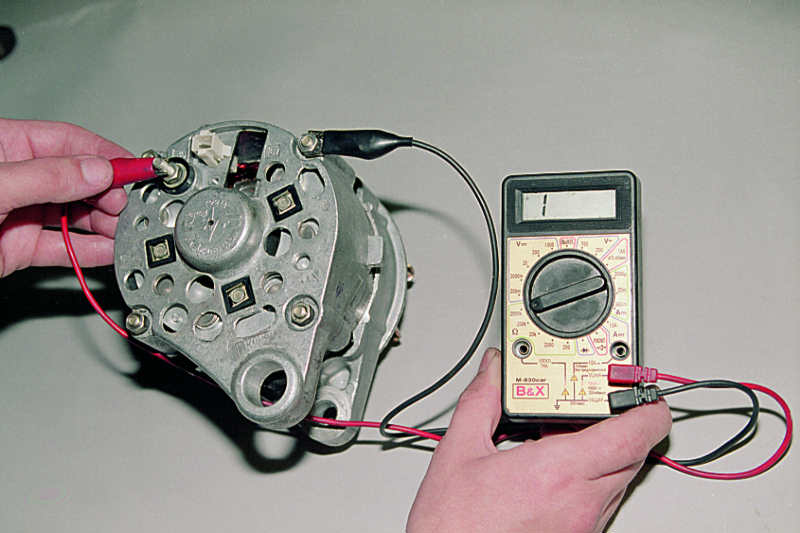
It is carried out in the following order:
1) Checking the fuse. If it is not working, it is replaced.
2) If the fuse is working, inspect the housing, its integrity and location. It is necessary to check the rotation of the rotor, the integrity and tension of the belt, and whether the wire connections are damaged.
3) Check slip rings and brushes. During operation, the brushes wear out and can sometimes jam. Slip rings become dirty over time and their grooves become clogged with graphite dust.
4) Check bearings and stator. Bearing wear is indicated by a howling or whistling sound during generator operation.
5) The rotor is diagnosed: the field windings are checked for breaks and short circuits. The multimeter must be switched to measure resistance and connected to the slip rings of the generator. If the measured resistance is below 1.8 ÷5 Ohms, there is a short circuit in the turns. If it is higher than this interval, there is a winding break.
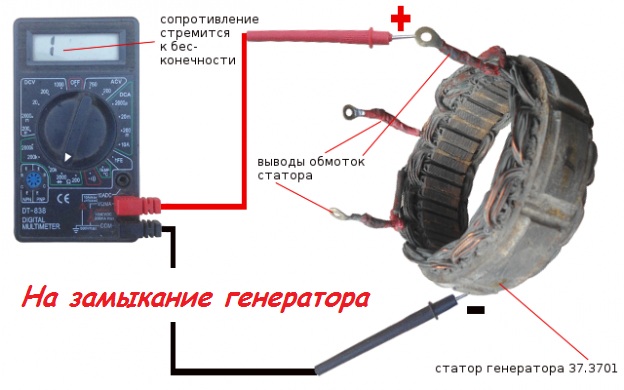
6) To check the field windings for ground, you need to disconnect them from the rectifier. If the multimeter gives an infinitely high resistance reading, it means that the stator windings are not touching the housing (“ground”).
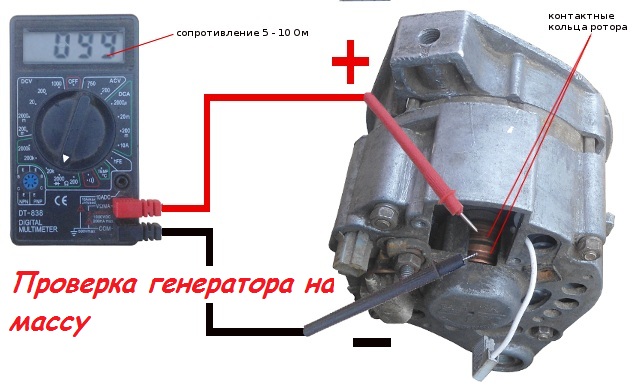
7) Having disconnected the multimeter from the stator windings, you need to switch the device to the “diode check” mode. The plus of the multimeter is connected to the rectifier terminal, the minus to the phase terminal. They take readings. Then the probes are swapped. Readings are taken again. A faulty diode bridge will have the same readings. If the readings are very different from each other, then the unit is working. The diode bridge fails if the contacts oxidize due to overheating of the radiator.
Why does the generator break down in a car?
- wear during operation, corrosion;
- installation of low-quality components;
- improper operation outside the recommended operating modes;
- influence of external unfavorable factors (road “chemistry”, heat, dirt, salt).
Troubleshooting and repair of car generators
Any worn or faulty parts found are replaced with new ones. The previously practiced rewinding of rotor or stator windings is now unprofitable. More often, brushes, bearings, and belts require replacement. You can easily do it yourself minor work. For example, solder wires torn off from the output terminals. Wash the slip rings with gasoline and dry.
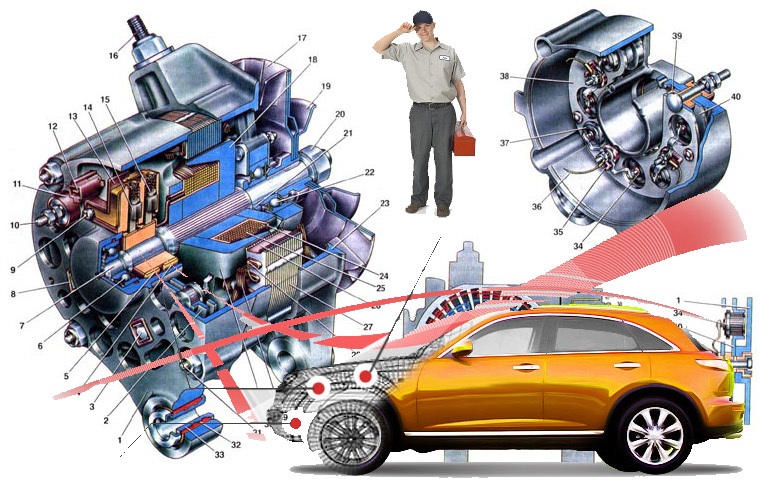
WITH simple repair, which does not require professional skills and highly qualified auto mechanics, you can handle it yourself. We must remember that repairs should be approached wisely, and do not repair the part that is easier to buy and replace with a new one. After all, the old one will fail faster, and repairs will turn into an endless process.
Obviously, you can diagnose the operation of the generator components yourself. This requires desire, very few tools and time. If you don’t have the desire or time, you can always turn to to an experienced master. The main thing is not to ignore such an important component, so that traveling by car brings pleasure, and does not force you to solve new problems.
